|

Athens
The history of Athens,
a city for 3500 years, dates back at least 5000 years.
The natural landscape, the sea and the climate were
determining factors in the make-up of its people and
contributed to the creation of an exceptional civilization;
a civilization that left its mark on the entire ancient world and laid the
foundations for the modern one. Ancient Athens'
greatest glory was during the classical period of ancient
Greece from which so many buildings and artifacts still
survive. The 5th century BCE in particular was a golden
age, when Pericles set about transforming the Acropolis
into a city of temples after being informed by the Delphic
oracle in 510 BCE that it should become a province of the
gods.
Within the Byzantine Empire and under Ottoman rule, Athens
played only a minor role. It returned to prominence in
1834 when it became the capital of Greece. Today it is
a busy and modern metropolitan center with a
population of four million.
Click on the thumbnails below in order to see pictures of Athens. Use your browser's back button
to return to this page.

|
|
|
|
|
|
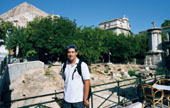
The Monument of
Lysiskrates (right), located in the east of the Plaka district, and the Acropolis (top
left). Lysiskrates was a very wealthy citizen of ancient Athens, who
sponsored many theatrical performances in the Theater
of Dionysus, a common practice by the rich people of that time. In 344
BCE, one of the performances he had sponsored was awarded the first prize
and
Lysiskrates received the
honors. In memory of this honor, he financed and built this choregic
monument, the only intact choregic monument remaining in the city of
Athens.
|
|
 The
Lysiskrates Monument. This is the earliest known example where Corinthian
columns are used externally. Six marble columns rise in a circle to a
marble dome decorated with an elephant finial of acanthus leaves that
supported the winner's bronze trophy. A frieze, probably the theme of the
winners' performance, depicts the battle between Dionysus and Tyrrhenian
pirates. Surrounded by satyrs, the god transforms the pirates into
dolphins and their ship's mast into a sea serpent. The
Lysiskrates Monument. This is the earliest known example where Corinthian
columns are used externally. Six marble columns rise in a circle to a
marble dome decorated with an elephant finial of acanthus leaves that
supported the winner's bronze trophy. A frieze, probably the theme of the
winners' performance, depicts the battle between Dionysus and Tyrrhenian
pirates. Surrounded by satyrs, the god transforms the pirates into
dolphins and their ship's mast into a sea serpent.
|
|
 Our favorite jewelry store in
the Plaka was this one: Placa's Agora Workshop located at 12-14 Vironos
Str. We spent lots of money
here. LOTS. Notice how much the owner is smiling... enough said. J Our favorite jewelry store in
the Plaka was this one: Placa's Agora Workshop located at 12-14 Vironos
Str. We spent lots of money
here. LOTS. Notice how much the owner is smiling... enough said. J |
|
|
|
|
|
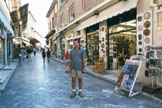
Walking through the Plaka's stone-paved, narrow labyrinthine streets. The
Plaka
is the center of Athens and has been so since
antiquity. It is located on the northeastern slopes of
the Acropolis rock. This is
Athens' oldest and, thanks to the restoration efforts which
went into its buildings in recent years, most picturesque neighborhood. |
|
 Our
last dinner in Greece was at our favorite restaurant in the Plaka --
Picolino's. Our
last dinner in Greece was at our favorite restaurant in the Plaka --
Picolino's. |
|
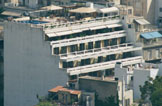 The
Electra
Palace Hotel, our primary hotel in Athens, as seen from the
Acropolis. It is located
in the Plaka within easy walking distance of all the major sites in
Athens. The
Electra
Palace Hotel, our primary hotel in Athens, as seen from the
Acropolis. It is located
in the Plaka within easy walking distance of all the major sites in
Athens. |
|
|
|
|
|

Lycabettus Hill as seen from the Electra Palace. The peak of Lycabettus reaches 277 meters (910 feet)
above the city and is its highest hill. The hill derives its name from the
popular belief that wolves (lýkoi) lived here. |
|
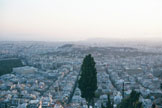
A
panorama from Lycabettus: the Acropolis, the hill of Philopappos, Piraeus
and the Saronic Gulf. |
|
 View of Athens from
Lycabettus hill. The open-air Lycabettus Theater
where contemporary jazz, pop and dance performances are held annually
during the Athens Summer Festival is visible
to the left. View of Athens from
Lycabettus hill. The open-air Lycabettus Theater
where contemporary jazz, pop and dance performances are held annually
during the Athens Summer Festival is visible
to the left. |
|
|
|
|
|
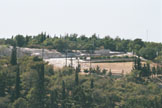 Hill
of the Pnyx, the meeting place of the ancient Athenian Democratic
Assembly. Today's role for the Pnyx, as outdoor theater for multilingual
sound-and-light performances, seems a sad fate for the home of 4th and 5th
century BCE democracy. In its heyday, 6000 Athenians gathered 40 times a
year to listen to speeches and make vital political decisions. Hill
of the Pnyx, the meeting place of the ancient Athenian Democratic
Assembly. Today's role for the Pnyx, as outdoor theater for multilingual
sound-and-light performances, seems a sad fate for the home of 4th and 5th
century BCE democracy. In its heyday, 6000 Athenians gathered 40 times a
year to listen to speeches and make vital political decisions. |
|
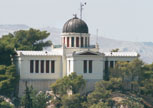
The Asteroskopeíon (Observatory) on the Hill of the Nymphs. The
Asteroskopeíon, built in 1842, occupies the site of a sanctuary to nymphs
associated with childbirth. |
|
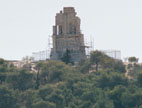 The
burial Monument to Philopappos on the Hill of the Muses was built in honor of
Gaius Julius Antiochus Philopappos in 114-116 CE. It was the Athenian way
of expressing their gratitude to a generous citizen of Syrian origin who, as Roman consul,
had distinguished himself by building many monuments and passing decrees
for the good of the city. Its unusual concave marble facade, 12 meters (40
ft.) high, contains niches with statues of Philopappos and his
grandfather, Antiochus IV. A frieze around the monument depicts the
arrival of Philopappos by chariot for his inauguration as Roman consul in
100 CE. The
burial Monument to Philopappos on the Hill of the Muses was built in honor of
Gaius Julius Antiochus Philopappos in 114-116 CE. It was the Athenian way
of expressing their gratitude to a generous citizen of Syrian origin who, as Roman consul,
had distinguished himself by building many monuments and passing decrees
for the good of the city. Its unusual concave marble facade, 12 meters (40
ft.) high, contains niches with statues of Philopappos and his
grandfather, Antiochus IV. A frieze around the monument depicts the
arrival of Philopappos by chariot for his inauguration as Roman consul in
100 CE. |
|
|
|
|
|
 The
Panathenaic Stadium, on Mets Hill, is the Stadium where the first modern
Olympic Games were held on April 5, 1896. The white Pentelic marble stadium was constructed on the site of the
original Panathenaic stadium,
which was built by Lykourgos in 330-329 BCE. The
Panathenaic Stadium, on Mets Hill, is the Stadium where the first modern
Olympic Games were held on April 5, 1896. The white Pentelic marble stadium was constructed on the site of the
original Panathenaic stadium,
which was built by Lykourgos in 330-329 BCE. |
|
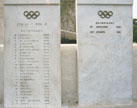
The Olympiad locations since 1896.
|
|
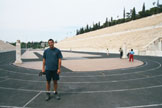 The
Panathenaic Stadium is 204 meters (669
ft) long and 83 meters (272 ft) wide and can seat up to 60,000 spectators. The
Panathenaic Stadium is 204 meters (669
ft) long and 83 meters (272 ft) wide and can seat up to 60,000 spectators. |
|
|
|
|
|
 The thrones in the
Panathenaic Stadium. The thrones in the
Panathenaic Stadium. |
|

The National Archeological Museum of
Athens houses magnificent gold artifacts from Mycenae
and spectacular Minoan frescoes from Santorini (Thira), among other
exquisite objects and antiquities. |
|
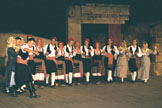 The
dancers at the Dóra Strátou Dance Theater, located on the Hill of the Muses, perform
traditional regional Greek dancing nightly between May and September. The
dancers at the Dóra Strátou Dance Theater, located on the Hill of the Muses, perform
traditional regional Greek dancing nightly between May and September. |
|
|
|
|
|
 The
Dóra Strátou Dance Theater. The
Dóra Strátou Dance Theater. |
|
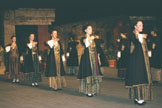
The Dóra Strátou Dance Theater. |
|
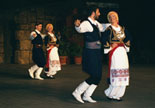 The
Dóra Strátou Dance Theater. The
Dóra Strátou Dance Theater. |
|
|
|
|
|
 The
Greek Parliament building located in Sintagma Square. The
Greek Parliament building located in Sintagma Square. |
|

The monument of the Unknown Soldier, in front of the
Greek Parliament building. The monument is decorated with an evocative
relief of a dying Greek hoplite. Unveiled on March 25, 1932 (National
Independence Day), the tomb is flanked by texts from Pericles famous
funeral oration. |
|
 The
monument is guarded day and night by a pair of elite soldiers called
Évzones. They are on continuous patrol in front of the tomb. The soldiers are dressed in the
traditional uniform of Tsolias (kilt and pom-pom clogs). The
monument is guarded day and night by a pair of elite soldiers called
Évzones. They are on continuous patrol in front of the tomb. The soldiers are dressed in the
traditional uniform of Tsolias (kilt and pom-pom clogs). |
|
|
|
|
|
 Hopping
aboard our plane to Herakleion in the West
Terminal of the Athens
Airport. Hopping
aboard our plane to Herakleion in the West
Terminal of the Athens
Airport. |
|
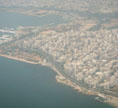 View
of Athens, Piraeus
and the Saronic Gulf from the plane. View
of Athens, Piraeus
and the Saronic Gulf from the plane. |
|
|
|
|
|
|
|
© All pictures are Copyright 2000 Grisel Gonzalez and Jeff
Prosise
|